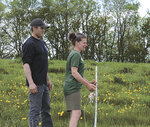CUBA CITY, Wis. – When Kelly Placke-Raaum returned to her family farm in 2014, she was returning to an organic, grass-fed dairy farm. She and her husband, Nick Raaum, have spent the last eight years taking the organic practices to the next level and diversifying in unconventional ways.
“We call it farmsteading,” Raaum said. “It’s low input, kind of low output, but high quality. We are just giving ourselves time to diversify and produce our own food and enjoy the country life more.”
The couple milks 38 cows near Cuba City. Their milk is shipped to Organic Valley and marketed as grassmilk. Kelly’s father had joined this niche market in 2013, at the birth of the Grassmilk market.
In order to achieve a 100% grass-fed diet in Wisconsin, the couple grazes their animals during the summer and feed dry hay and baleage over the winter. They said some farmers achieve the grass-fed diet by feeding sorghum and sudangrass in silages and even sterile corn.
The goal with the grass-fed diet is to produce high omega-3 and high CLA milk. When cows are fed starch, the fatty profile changes, and the quality of the product changes with it.
The premium paid for the Grassmilk market has allowed the couple to explore other avenues of diversification, like perennial farming.
“When I look at all the inputs going into systems, I think there’s room for ecologically integrated agriculture systems that are lower input,” Raaum said. “I think there’s a need for carbon negative, low inputs, lower ecological footprint and higher quality outputs.”
Prior to running the dairy farm, Raaum was in the energy industry, and Placke-Raaum was a teacher and also spent time traveling and participating in the World Wide Opportunities in Organic Farming program.
“So much of our money was going to feed ourselves organic food,” Placke-Raaum said. “That’s why I thought we should just do the job. We might not make much money right away but at least we’ll eat well.”
The couple has introduced tree crops to their hedgerows as a way to provide shade and eventually supplement the cows’ diets. They have planted hazelnut, honey locust, chestnut and plum trees as well as an acre of elderberries. They have also added pasture raised hogs to their repertoire and utilize tree crops in their hog pasture as well.
Raaum thinned out a patch of woods that had been choked out with boxelder trees and planted fruit and nut trees in their place. Hogs are raised in this environment, and the couple are slowly starting to market them privately.
Right before Placke-Raaum returned to the farm, her dad had installed solar panels. The panels offset any carbon that the farm produces and produce about as much electricity as the farm uses in the barn. Whatever energy is overproduced is sold back to the grid since there is no storage capacity on the farm.
The couple has found bountiful benefits to grazing the cows.
“We are letting the animals do as much work as we can get away with,” Raaum said. “They are harvesting their own feed, spreading their own manure. Running the vacuum pump was really all that we’ve put into them today.”
The cows are so comfortable on the grass that the Plackes were having a hard time getting them to come in for evening milking. With a new baby on the way, the couple switched to once-a-day milking three years ago to save on labor. Placke-Raaum said the cows adjusted well to the change.
“It did not move our somatic cell count at all,” Placke-Raaum said. “And our components went way up, which is what Organic Valley pays us for.”
Raaum said the cows are producing around 70% of what they were producing on twice-a-day milking, and the quality is better. The couple also agreed the cows’ body condition has improved since changing to once-a-day milking.
Around the same time that they switched to milking once, they also started letting the calves run with the cows instead of raising them separately. Placke-Raaum refers to it as the madre method, and the couple has seen benefits to the system.
“Our heifers coming in that were raised this way are amazing,” Raaum said. “Since they don’t get grain to accelerate their growth, getting the better milk nutrition from their mom for so long really helps speed up their growth in our system.”
Placke-Raaum agreed.
“It really teaches them the system too,” she said. “The calves start grazing at 2-3 weeks old, and they learn to respect single strand, polywire fencing.”
The couple relies on their genetics to help make the grazing system work. They have Holstein-Jersey crosses and Fleckvieh.
“Having cows that are able to keep condition and do better in a forage-based diet is huge,” Raaum said. “It’s so easy to dial it in when you have corn silage and grain in a ration so breeding plays a big part for us.”
Raaum said their philosophical hunch is that healthy soil creates healthy animals and healthy food.
“It basically goes back to the health of the soil which you can only get in a perennial cropping system,” he said. “The cows live longer, are healthier, and our cull rate is extremely low.”
The couple believes their methods provide a more forgiving way to dairy.
“Conventional has pushed the envelope on yields, really minimizing labor but it’s so unforgiving when things go awry,” Raaum said. “I realize we are speaking from a place of privilege with this niche market, but a lot of those guys have it so challenging. And, I could never imagine that.”
The couple said their methods are nothing new.
“We are kind of going the opposite direction of progressive dairying,” Placke-Raaum said. “We essentially want to farm the way our grandparents did.”


Comments
No comments on this item Please log in to comment by clicking here